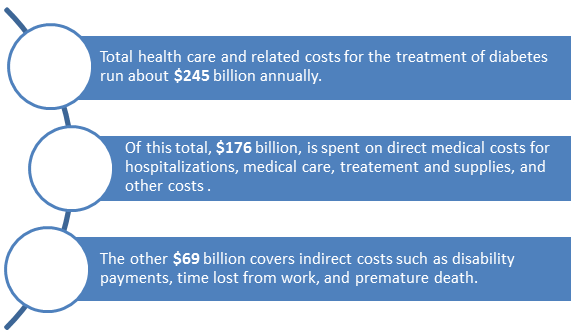Diabetes and the Workplace
Focus on Wellness and Safety
Employers are a major source of health benefits for Americans. Worksite wellness programs have developed primarily to contain and reduce quickly escalating health care costs and to improve productivity and reduce absenteeism and presenteeism (the worker is present, but not working productively).

After adjusting for population age and sex differences, average medical expenditures among people with diagnosed diabetes were 2.3 times higher than what expenditures would be in the absence of diabetes. Read more in "Economic Costs of Diabetes in the U.S. in 2012."
The largest components of medical expenditures for diabetes are
- Hospital inpatient care (43% of the total medical cost),
- Prescription medications to treat complications of diabetes (18%),
- Medications to manage diabetes/blood glucose levels and diabetes supplies (12%),
- Physician office visits (9%),
- In-home nursing care/non-hospital residential facility stays (8%).
People with diagnosed diabetes incur average medical expenditures of about $13,700 per year, of which about $7,900 is attributed to diabetes. People with diagnosed diabetes, on average, have medical expenditures approximately 2.3 times higher than what expenditures would be in the absence of diabetes.
Indirect costs of diabetes include
- Increased absenteeism ($5 billion),
- Reduced productivity while at work ($20.8 billion) for the employed population,
- Reduced productivity for those not in the labor force ($2.7 billion),
- Inability to work as a result of disease-related disability($21.6 billion),
- Lost productive capacity due to early mortality ($18.5 billion)
What can you do?
Make the strongest impact on health care costs and productivity by focusing on
- Diabetes prevention and management education.
- Heart health, blood pressure and cholesterol management.
- Tobacco use cessation.
- Weight management.
- Stress management.
- Address placement issues and safety, such as: hypoglycemia, types and timing of diabetes medications, diabetic complications, type of work (physically active vs. sedentary job), using heavy machinery, and shift work. Specific information about the safety needs of employees with diabetes can be found at the EEOC .
Learn more information about worksite wellness and safety programs at CDC's Total Worker Health and Workplace Health Promotion sites.
Aids & Tools
Know More
1. Find resources about worksite wellness and health promotion from the Centers for Disease Control and Prevention.
- The Steps to a Healthier U.S. Workforce Initiative was developed by the National Institute for Occupational Safety and Health (NIOSH), modeled after the U.S. Department of Health and Human Services (HHS) initiative, Steps to a Healthier U.S. The initial goals of the Steps to a Healthier U.S. Workforce were to protect, support, and enhance the health of workers through comprehensive programs. Beginning with Steps to a Healthier U.S. Workforce and continuing with the Worklife Program, NIOSH has promoted the integration of programs designed to protect worker health and safety on the job with health promotion and wellness programs to more effectively protect, improve, and promote both organizational and individual health and well-being.
- The National Healthy Worksite Program is designed to assist employers in implementing science and practice-based prevention and wellness strategies that will lead to specific, measurable, health outcomes to reduce chronic disease rates. For most employers, chronic diseases -- such as heart disease, stroke, cancer, obesity, arthritis and diabetes -- are among the most prevalent, costly, and preventable of all health problems. The National Healthy Worksite Program seeks to promote food health through prevention, reduce chronic illness and disability, and improve productivity outcomes that contribute to employers' competitiveness.
- Learn more about worksite wellness and safety from the American College of Occupational and Environmental Medicine.
- Learn more about worksite wellness and safety can be found from the National Business Group on Health.
- The Centers for Disease Control also has resources within the Total Worker Health Initiative.
- The National Business Coalition on Health also has resources for employers.
Ask More
- Many of our employees have diabetes. What can we do to provide programs and resources for them?
Answer:
The Diabetes at Work Web site provides numerous resources and support to help you provide support and information to your colleagues. Check out the Right Fit, Resources and Build sections of this website to learn more about how to impact diabetes in your workplace.
- We would like to provide onsite health services at my company. Where can I learn more about onsite health services?
Answer:
The American College of Occupational and Environmental Medicine provides excellent resources about health care in the workplace.
- Can people with diabetes work schedules include shift work?
Answer:
Yes, people with diabetes can work shifts if accommodation is made for blood glucose monitoring and control. To learn more about diabetes and shift work go to resources found at the American Diabetes Association.
Do More
- Build diabetes prevention and management elements into your existing workplace wellness program. Learn more on this website at BUILD.
- Train supervisors about diabetes so that they are aware of the needs of employees with diabetes and how best to accommodate them. For more information visit the EEOC.
- Review your worksite safety policies and plans to be sure accommodations are included for people with diabetes. For more information on diabetes accommodations go to American Diabetes Association.
- Page last reviewed: December 29, 2016
- Page last updated: December 29, 2016
- Content source:
- Maintained By:


 ShareCompartir
ShareCompartir